
| Home | Deepsky Atlas | TheAstronews | Links | Solar System | ||||||

Hawaiian Astronomical SocietyConstellations: Carina -- Keel of Argo Navis |
||||||||||
Mythology's greatest heroes, in their quest for the Golden Fleece needed a ship larger than any ever built. For this task, Argus of Thespia supervised the construction of this gigantic vessel. Workers brought seasoned timber from nearby Mount Pelion. Athena herself brought a board and placed it into the new ship's prow; cut from Zeus's sacred oak, it could magically speak prophecies. Jason commanded the ship. Among her crew served Hercules, Castor & Pollux, Orpheus, Theseus, and the maiden Atalanta. The Argo left the port around 1300 B.C. or in the 3rd century B.C. as others say.
After saving Phineus from hideous birds called Harpies, the "Argonauts" had to make passage through the Clashing Rocks. These great rocks guarded the very narrow entrance to the Bosphorus by crushing anything in their way. The Jason released a dove, to see if the bird could fly through the entrance before the rocks clashed. When the thunder subsided and the rocks parted, they saw that the dove had escaped, its tail clipped by the rocks, the race was so close. As the rocks moved apart, Jason urged his men to row their hardest. The rocks closed in, looming on both sides through the mist. The ship sped forward through the clashing rocks; the ship reeled, but only its stern was destroyed. Argo made it, but barely. In tribute to the crew's courage and strength, the gods brought the giant rocks lurching to a halt and they never again denied passage to sailors.
Eventually the Argo reached Colchis, where King Aeetes held the Golden Fleece. The fleece, when it lived, was a ram (see Aries) that had carried Jason's cousins to safety in Colchis. Aeetes agreed to surrender the fleece, but first set Jason an impossible task. First he must yoke two wild bulls (gifts of the volcanic god Hephaestus) who snorted fire, whose hoofs were brass. With them he must plow a field, and sow it with dragon's teeth, from which armed men sprang to attack him. Next, he must approach the dragon that guarded the fleece.
The quest would have been lost, but the goddess of love, Aphrodite, had her son, Cupid, shoot an arrow into Aeetes' beautiful daughter Medea, causing her to fall in love with Jason. A powerful sorceress, she proved quite useful. She helped Jason overcome each of the obstacles, and fled with him and the captured fleece. Aeetes gave chase, his ships closing on the Argo. Medea dismembered her younger brother, and cast the parts in the sea. Aeetes paused to pick up the pieces, and the Argo escaped.
There are many accounts of the return home, from simple to complex. One account has the Argo sailing literally around the known world, its sailors encountering adventure after adventure. Jason died, when near home, the stern (or poop) of the Argo collapsed on him.
The more common account has him retracing his steps, marrying Medea on his return, and living in Corinth for many years. The end of the story was anything but happy. Jason abandoned Medea to marry Glauce, a daughter of Creon, the King of Corinth. Medea appeared not to mind. She presented Glauce with a robe. When she wore it, it burst into flame, killing her. Medea then killed her own children fathered by Jason, and fled in a chariot pulled by dragons to Athens.
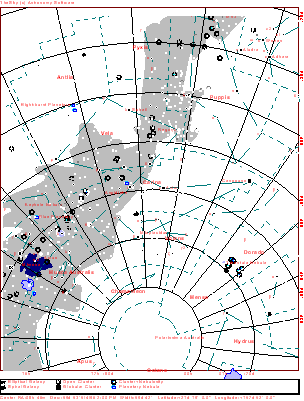
Click the map for a 909x1199 version of the above. Click here for a map better suited for use in the field.
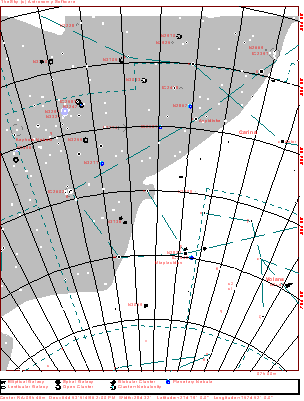
This is the north-east section of the constellation. The map displays stars to magnitude 10, and deepsky objects to magnitude 12. Click here for a map better suited for use in the field.
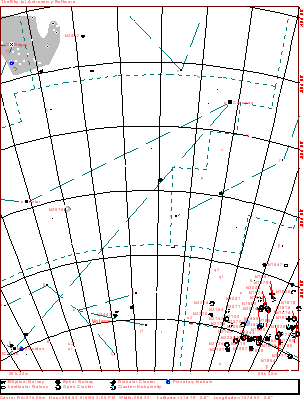
Click here for a map better suited for use in the field.
 88k JPEG NGC2516 (Caldwell 96) is a very bright, very large, fairly rich open cluster located 3.3° WSW of Avior (Epsilon Carinae). It consists of about 80 stars from mags. 7-13. From the Digital Sky Survey. 88k JPEG NGC2516 (Caldwell 96) is a very bright, very large, fairly rich open cluster located 3.3° WSW of Avior (Epsilon Carinae). It consists of about 80 stars from mags. 7-13. From the Digital Sky Survey.
|
 14k JPEG NGC2808 (Bennett 41) is another of Dreyer's remarkable objects. Described as very large (14'), extremely rich, and gradually reaching and extremely condensed status in the middle, it contains stars at mags. 13-15. This means you should get hints of resolution from a 6" at a dark site. It is located 3.7° west of Upsilon Carinae, and 5.7° south of Aspidiske (Iota Carinae). From the Digital Sky Survey. 14k JPEG NGC2808 (Bennett 41) is another of Dreyer's remarkable objects. Described as very large (14'), extremely rich, and gradually reaching and extremely condensed status in the middle, it contains stars at mags. 13-15. This means you should get hints of resolution from a 6" at a dark site. It is located 3.7° west of Upsilon Carinae, and 5.7° south of Aspidiske (Iota Carinae). From the Digital Sky Survey.
|
 37k JPEG NGC2867 (Caldwell 90), yet another of Dreyer's remarkable objects. A small (12"), round, multi-shelled planetary nebula shining at mag. 9.7. It lies 1.1° NE of Aspidiske (Iota Carinae). From the Digital Sky Survey. 37k JPEG NGC2867 (Caldwell 90), yet another of Dreyer's remarkable objects. A small (12"), round, multi-shelled planetary nebula shining at mag. 9.7. It lies 1.1° NE of Aspidiske (Iota Carinae). From the Digital Sky Survey.
|
 90k JPEG NGC3114 is an open cluster described as extremely large (35'), bright (mag. 4.2), little condensed, with stars ranging from mags. 9-14. It sits 5.8° east of Aspidiske (Iota Carinae). One degree image from the Digital Sky Survey. 90k JPEG NGC3114 is an open cluster described as extremely large (35'), bright (mag. 4.2), little condensed, with stars ranging from mags. 9-14. It sits 5.8° east of Aspidiske (Iota Carinae). One degree image from the Digital Sky Survey.
|
 78k JPEG NGC3199 is still another of Dreyer's remarkable objects. A very large (22'), very bright (no magnitude given) nebula described as "falcate," meaning hooked like a scythe. Dreyer also mentions the involvement of a double star. It lies 4.3° SE of Phi Velorum. This image from the Digital Sky Survey bears the marks of heavy processing to bring out the nebula. 78k JPEG NGC3199 is still another of Dreyer's remarkable objects. A very large (22'), very bright (no magnitude given) nebula described as "falcate," meaning hooked like a scythe. Dreyer also mentions the involvement of a double star. It lies 4.3° SE of Phi Velorum. This image from the Digital Sky Survey bears the marks of heavy processing to bring out the nebula.
|
 78k JPEG NGC3293 is an open cluster described as fairly large (6'), bright (mag. 4.7), rich open cluster, located 1.9° NW of the Eta Carina Nebula. It is the larger cluster in this image. 78k JPEG NGC3293 is an open cluster described as fairly large (6'), bright (mag. 4.7), rich open cluster, located 1.9° NW of the Eta Carina Nebula. It is the larger cluster in this image.
NGC3324 is a small cluster with nebulosity in the lower left of the image. Dreyer says it is fairly bright (mag. 6.7), very (two of them) large (6' for the cluster, 16' for the nebulosity), irregular in shape (the nebulosity) and with a double star involved.
|
 290k GIF NGC3372 (Caldwell 92, sometimes called the Keyhole) is a spectacular nebulosity around the star Eta Carinae. Eta was second brightest only to Sirius in the night sky in the 19th century. It is surrounded by nebulosity so bright it casts a reflection on the ocean when viewed from the summit of Haleakala on Maui. 290k GIF NGC3372 (Caldwell 92, sometimes called the Keyhole) is a spectacular nebulosity around the star Eta Carinae. Eta was second brightest only to Sirius in the night sky in the 19th century. It is surrounded by nebulosity so bright it casts a reflection on the ocean when viewed from the summit of Haleakala on Maui.
|
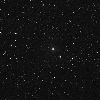 94k JPEG IC2602 (Caldwell 102) is an open cluster located 4.5° south of the Eta Carinae Nebula. It includes Theta Carinae as well as 59 other stars. The brightest stars are mag. 2.8, most, however are mag 5 and fainter. A member of the Scorpius-Centaurus Association. From the Digital Sky Survey. 94k JPEG IC2602 (Caldwell 102) is an open cluster located 4.5° south of the Eta Carinae Nebula. It includes Theta Carinae as well as 59 other stars. The brightest stars are mag. 2.8, most, however are mag 5 and fainter. A member of the Scorpius-Centaurus Association. From the Digital Sky Survey.
|
 99k JPEG NGC3532 (Caldwell 91), what can one say. Just when you thought the Eta Carinae Nebula was as good as it gets, you stumble across the best of all open clusters just 3° to the ENE. One of Dreyer's very remarkable objects, he calls it extremely large (55'), round, little compressed, with 150 stars from mags. 7-12. From the Digital Sky Survey. 99k JPEG NGC3532 (Caldwell 91), what can one say. Just when you thought the Eta Carinae Nebula was as good as it gets, you stumble across the best of all open clusters just 3° to the ENE. One of Dreyer's very remarkable objects, he calls it extremely large (55'), round, little compressed, with 150 stars from mags. 7-12. From the Digital Sky Survey.
|
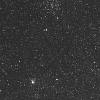 71k JPEG Melotte 105 (Collinder 246, Bennett 47) is the first of two clusters that lie within a degree of each other in north-eastern Carina at the Centaurus border. It has a combined magnitude is 8.5, and contains about 70 stars of mag. 11.1 and fainter. It covers about 4' of sky. 71k JPEG Melotte 105 (Collinder 246, Bennett 47) is the first of two clusters that lie within a degree of each other in north-eastern Carina at the Centaurus border. It has a combined magnitude is 8.5, and contains about 70 stars of mag. 11.1 and fainter. It covers about 4' of sky.
IC2714 lies 49' to the north. It shines at mag. 8, and features about 100 faint stars spread over a 12' area. Dreyer says it is compressed toward the west.
The atlas map shows both clusters in the constellation of Centaurus. This is due to an incorrectly drawn constellation boundary. The objects lie just over the boarder in Carina. Image from the Digital Sky Survey.
|
If you have any questions about the Hawaiian Astronomical Society
please
(link requires javascript).